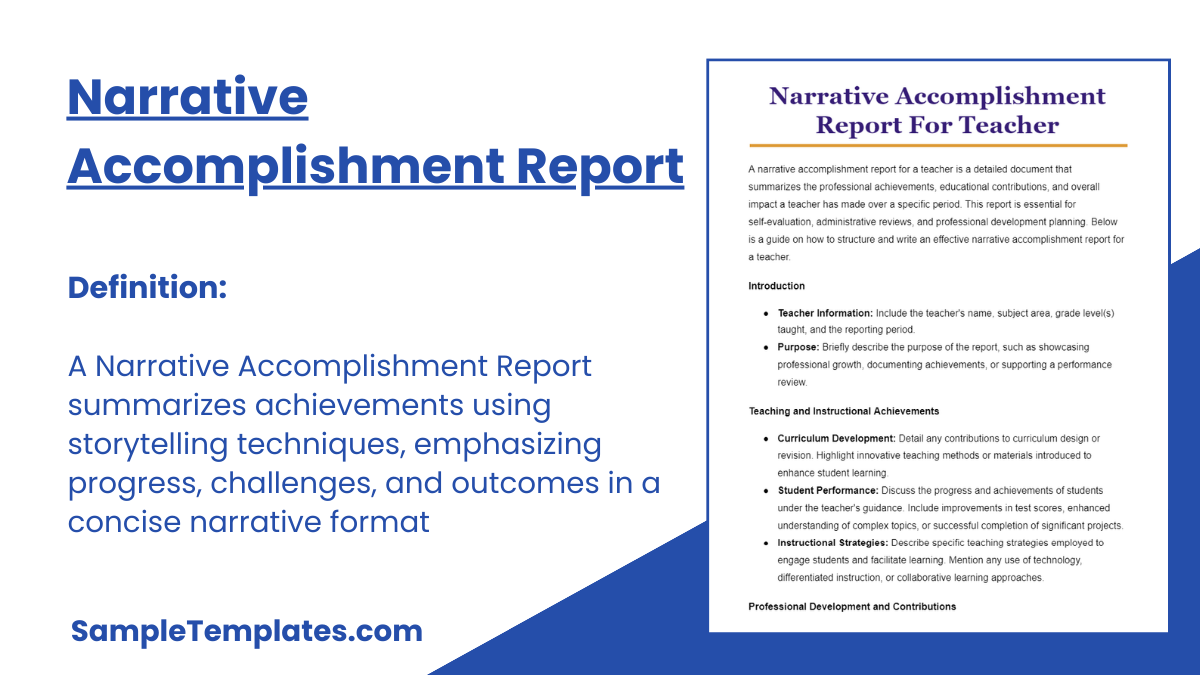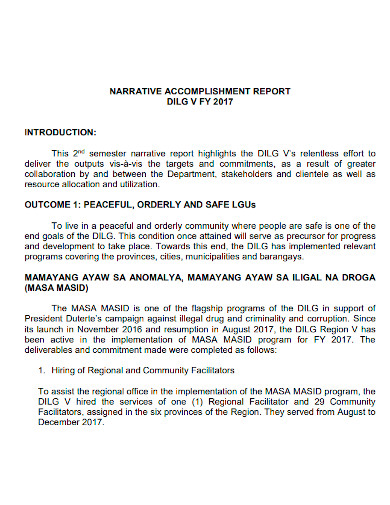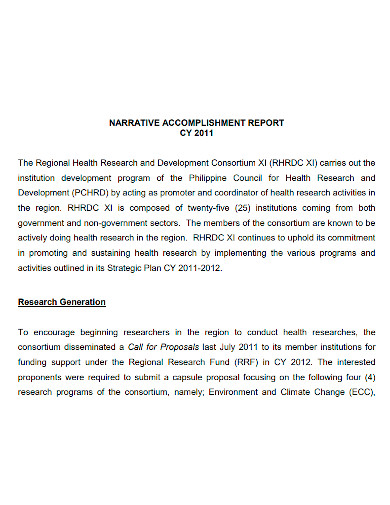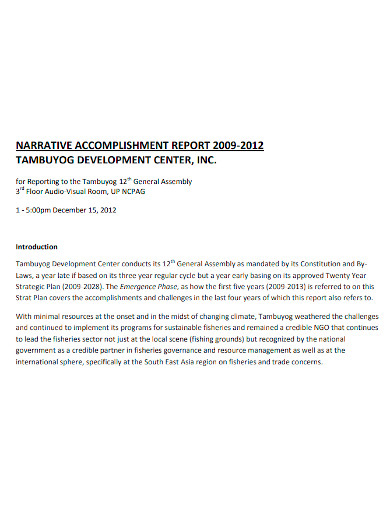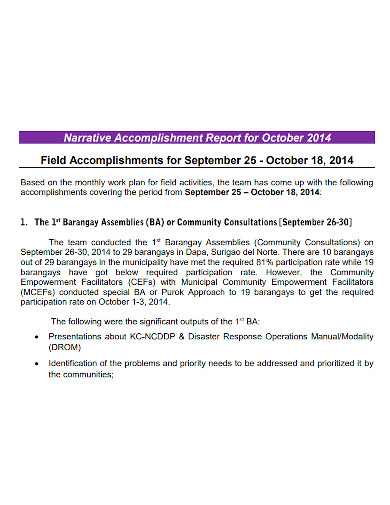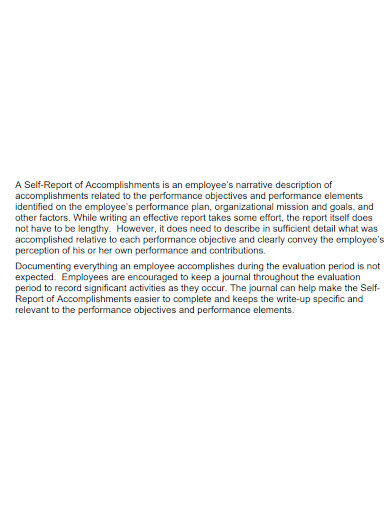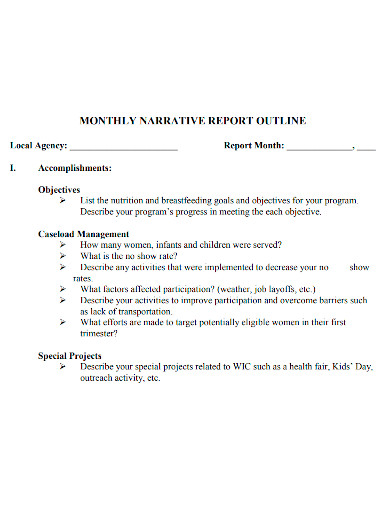Are you a science teacher? One of the fundamental things that you need to know and be aware of is the current status and performance management of the tasks, activities, and projects work entrusted to you. But how can you measure and monitor the overall performance and condition of your work in teaching the students? In this article, we have some informative guide and downloadable templates of accomplishment report in narrative form to guide you in carefully managing and keeping track of the progress of your job. Keep on reading!
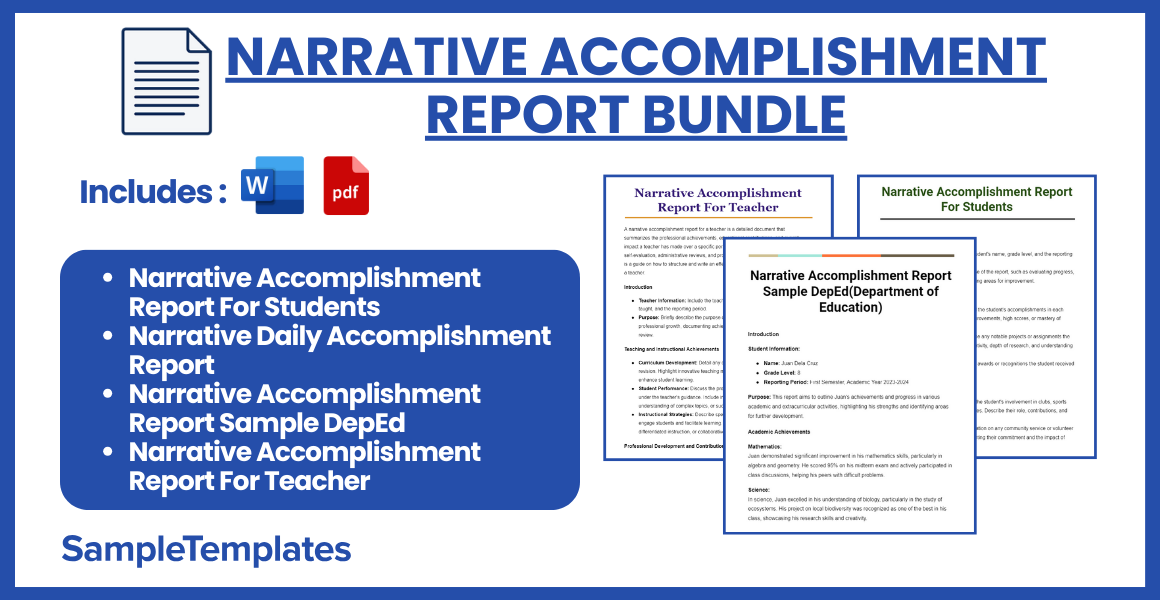
Download Narrative Accomplishment Report Bundle
Narrative Accomplishment Report For Students
Introduction
- Student Information: Include the student’s name, grade level, and the reporting period.
- Purpose: Briefly describe the purpose of the report, such as evaluating progress, celebrating achievements, or identifying areas for improvement.
Academic Achievements
- Subject-Specific Successes: Detail the student’s accomplishments in each subject area. Highlight significant improvements, high scores, or mastery of complex topics.
- Projects and Assignments: Describe any notable projects or assignments the student completed, emphasizing creativity, depth of research, and understanding of the subject matter.
- Awards and Recognitions: List any awards or recognitions the student received during the period.
Extracurricular Activities
- Clubs and Organizations: Mention the student’s involvement in clubs, sports teams, or other extracurricular activities. Describe their role, contributions, and any leadership positions held.
- Community Service: Include information on any community service or volunteer work the student engaged in, highlighting their commitment and the impact of their efforts.
Personal Growth and Development
- Skills Development: Discuss the development of important skills such as communication, problem-solving, and teamwork. Provide examples of how these skills were demonstrated.
- Challenges Overcome: Share instances where the student faced challenges and describe how they overcame them, showing resilience and determination.
- Behavioral and Social Adjustments: Comment on the student’s behavior and social interactions, noting improvements or exemplary conduct.
Goals and Future Plans
- Short-Term Goals: Outline any short-term academic or personal goals the student has set for the next reporting period.
- Long-Term Aspirations: Discuss the student’s long-term aspirations, including career interests or higher education plans.
- Support Needed: Identify areas where the student needs further support or resources to achieve their goals.
Conclusion
- Overall Evaluation: Provide a summary of the student’s overall performance, including strengths and areas for growth.
- Encouragement and Recommendations: Offer words of encouragement and specific recommendations for continued success.
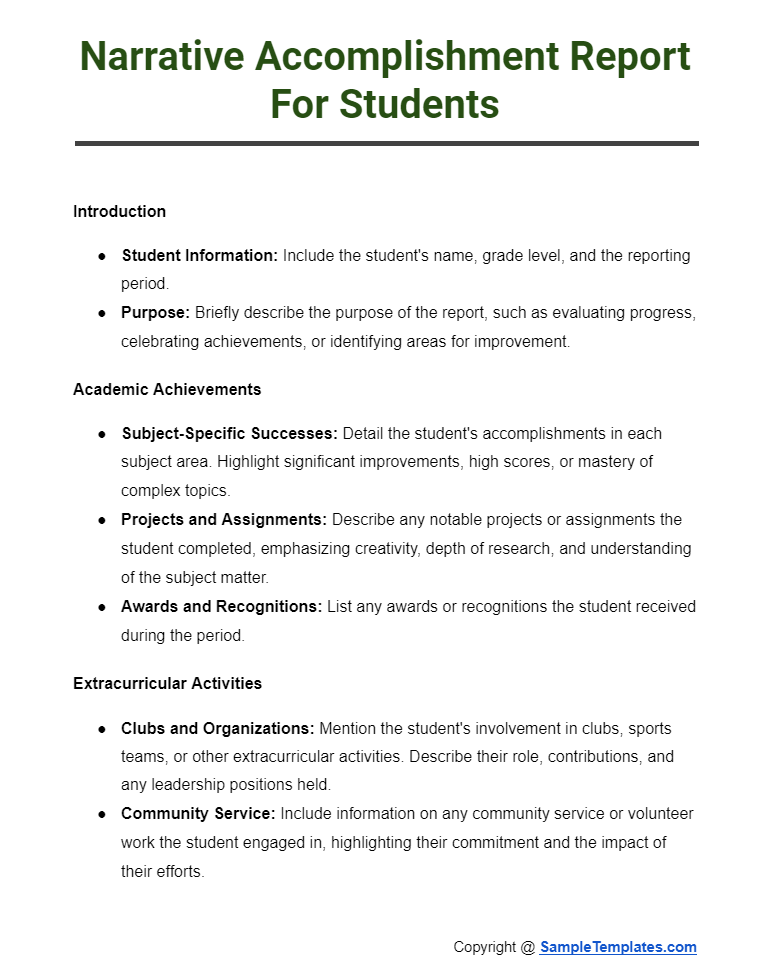
Narrative Daily Accomplishment Report
Introduction
- Student Information: Start with the student’s name, grade, and the specific date of the report.
- Objective: Briefly explain the purpose of the daily accomplishment report, such as monitoring progress, assessing daily activities, or enhancing student engagement.
Academic Performance
- Class Participation: Describe the student’s participation in class discussions, noting any insightful contributions or questions they raised.
- Assignments and Tasks Completed: List the assignments or tasks the student completed that day, detailing the quality of work and any challenges they overcame.
- Learning Outcomes Achieved: Highlight key learning outcomes or objectives met during the day and how the student demonstrated their understanding.
Extracurricular Participation
- Activities Engaged In: Note any extracurricular activities the student participated in, including sports, clubs, or other school events. Describe their involvement and any noteworthy achievements.
- Skill Development: Mention specific skills developed during these activities, such as teamwork, leadership, or time management.
Personal and Social Development
- Interactions and Social Skills: Discuss the student’s interactions with peers and teachers, highlighting positive social behaviors or improvements in communication.
- Behavioral Observations: Provide observations on the student’s behavior, including adherence to rules, respect for others, and overall conduct.
Challenges and Support
- Challenges Faced: Describe any academic or personal challenges the student encountered and how they dealt with them. Include any support provided by teachers or peers.
- Additional Assistance Needed: Identify areas where the student may need extra help or resources to enhance their learning experience.
Conclusion
- Summary of Achievements: Summarize the student’s accomplishments for the day, emphasizing strengths and key areas of progress.
- Recommendations and Next Steps: Offer suggestions for the next day to continue the student’s growth and address any areas of concern.

Narrative Accomplishment Report Sample DepEd(Department of Education)
Introduction
Student Information:
- Name: Juan Dela Cruz
- Grade Level: 8
- Reporting Period: First Semester, Academic Year 2023-2024
Purpose: This report aims to outline Juan’s achievements and progress in various academic and extracurricular activities, highlighting his strengths and identifying areas for further development.
Academic Achievements
Mathematics:
Juan demonstrated significant improvement in his mathematics skills, particularly in algebra and geometry. He scored 95% on his midterm exam and actively participated in class discussions, helping his peers with difficult problems.
Science:
In science, Juan excelled in his understanding of biology, particularly in the study of ecosystems. His project on local biodiversity was recognized as one of the best in his class, showcasing his research skills and creativity.
Language and Literature:
Juan showed a keen interest in literature, reading beyond the curriculum and engaging in literary discussions. He won the school poetry competition with his piece “The Beauty of Nature.”
Extracurricular Activities
Basketball Team:
Juan was a key player on the school basketball team, demonstrating leadership and teamwork. His dedication led to the team’s victory in the inter-school basketball tournament.
Science Club:
As a member of the Science Club, Juan participated in various science fairs and workshops. He collaborated on a project about renewable energy sources, which was presented at a regional science fair.
Personal Growth and Development
Social Skills:
Juan has shown remarkable improvements in his social interactions, becoming more confident and empathetic. He was often seen helping new students acclimate to the school environment.
Challenges Overcome:
Juan faced challenges in time management, especially with balancing his academic and extracurricular commitments. With guidance from his teachers, he developed a more effective schedule, improving his overall productivity.
Goals and Future Plans
Short-Term Goals:
Juan aims to improve his writing skills and participate in the upcoming school debate competition. He also plans to take advanced courses in mathematics to prepare for higher-level studies.
Long-Term Aspirations:
Juan is interested in pursuing a career in environmental science. He plans to join more environmental initiatives and explore internship opportunities in related fields.
Support Needed:
Juan requires continued support in developing his writing skills and additional resources for his advanced mathematics studies.
Conclusion
Overall Evaluation:
Juan has shown commendable progress across various domains. His ability to balance academic excellence with extracurricular involvement is a testament to his dedication and hard work.
Encouragement and Recommendations:
We encourage Juan to continue exploring his interests and to seek out opportunities that challenge him further. It is recommended that he receive additional support in writing and mathematics to foster his growth and prepare him for future academic challenges.

Narrative Accomplishment Report For Teacher
A narrative accomplishment report for a teacher is a detailed document that summarizes the professional achievements, educational contributions, and overall impact a teacher has made over a specific period. This report is essential for self-evaluation, administrative reviews, and professional development planning. Below is a guide on how to structure and write an effective narrative accomplishment report for a teacher.
Introduction
- Teacher Information: Include the teacher’s name, subject area, grade level(s) taught, and the reporting period.
- Purpose: Briefly describe the purpose of the report, such as showcasing professional growth, documenting achievements, or supporting a performance review.
Teaching and Instructional Achievements
- Curriculum Development: Detail any contributions to curriculum design or revision. Highlight innovative teaching methods or materials introduced to enhance student learning.
- Student Performance: Discuss the progress and achievements of students under the teacher’s guidance. Include improvements in test scores, enhanced understanding of complex topics, or successful completion of significant projects.
- Instructional Strategies: Describe specific teaching strategies employed to engage students and facilitate learning. Mention any use of technology, differentiated instruction, or collaborative learning approaches.
Professional Development and Contributions
- Training and Workshops: List any professional development activities the teacher participated in, such as workshops, seminars, or courses. Describe how these experiences have enriched their teaching practice.
- Mentoring and Leadership: Highlight the teacher’s role in mentoring new educators or leading professional learning communities. Discuss any leadership positions held within the school or educational community.
Extracurricular and Community Involvement
- School Activities: Note the teacher’s involvement in extracurricular activities, such as clubs, sports, or arts programs. Describe their role and the impact on student engagement and school culture.
- Community Engagement: Include any participation in community service projects, educational outreach programs, or partnerships with local organizations.
Challenges and Innovative Solutions
- Overcoming Obstacles: Share instances where the teacher faced challenges in their role and describe the innovative solutions implemented to overcome them.
- Adaptability: Discuss how the teacher adapted to changes in the educational environment, such as shifts to remote learning, new technology integration, or curriculum updates.
Goals and Future Plans
- Short-Term Goals: Outline the teacher’s immediate goals for the next academic period, including areas for professional growth or curriculum enhancement.
- Long-Term Aspirations: Discuss the teacher’s long-term career goals, such as pursuing advanced degrees, taking on administrative roles, or specializing in a particular area of education.
Conclusion
- Overall Evaluation: Provide a summary of the teacher’s overall performance, including strengths and areas for future improvement.
- Encouragement and Recommendations: Offer words of encouragement and specific recommendations for continued professional development and success in teaching.
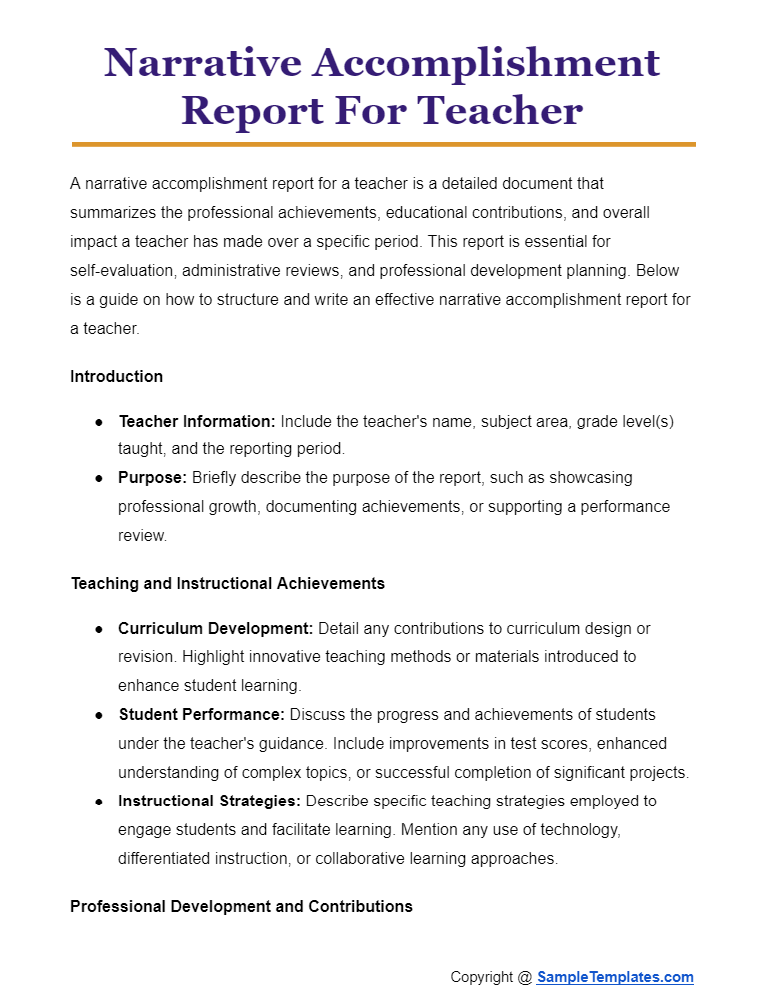
Browse More Templates On Narrative Accomplishment Report
1. Narrative Accomplishment Report Sample
2. Accomplishment Narrative Report
3. Narrative Accomplishment Report
What is the summary of the accomplishment report?
The summary of an accomplishment report provides a condensed overview of the key achievements and milestones within a specific period. It highlights successes, completed project design, and noteworthy contributions. This section typically offers a snapshot of the positive outcomes and impact of individual or team efforts, emphasizing results and progress note made during the reporting period.
4. Narrative Report Sample
5. Example Of Narrative Accomplishment Report
Tips For Writing a Narrative Accomplishment Report
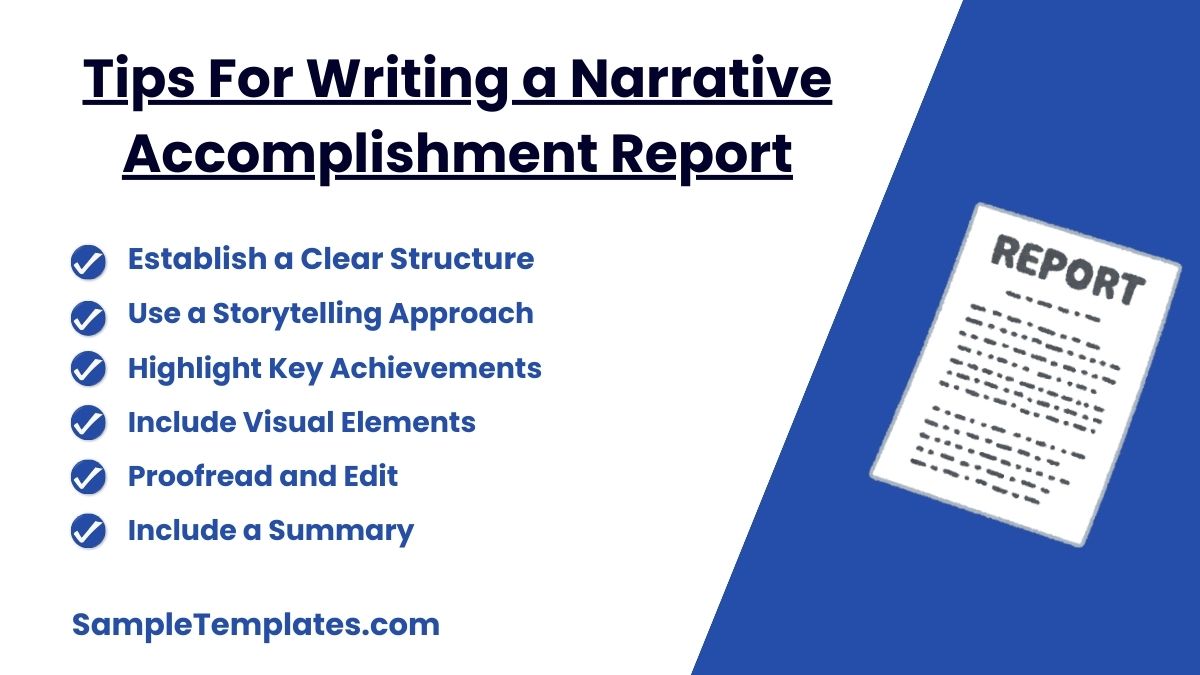
Writing a narrative accomplishment report effectively communicates the progress and results of a project or period in a way that is engaging and easy to understand. Here are some tips to help you craft a compelling narrative accomplishment report:
1. Understand Your Audience
- Tailor the content and language of the report outline to suit the needs and understanding of your audience, whether it’s management, stakeholders, or team members. Knowing your audience helps in emphasizing the aspects of the report they would most care about.
2. Establish a Clear Structure
- Organize the report logically. Common structures include chronological (by time), thematic (by topic), or by key objectives. A clear structure helps guide the reader through your narrative smoothly.
3. Use a Storytelling Approach
- Present information in a narrative style. Start with setting the scene (background and objectives), then move through the main body (actions taken, challenges, successes), and conclude with an ending (results, lessons learned, next steps). This makes the report more relatable and engaging.
4. Highlight Key Achievements
- Focus on significant achievements and their impact. Explain not just what was accomplished, but why it matters. This could include meeting major milestones, overcoming difficult challenges, or notable improvements in performance or efficiency.
5. Incorporate Quantitative and Qualitative Data
- Support your narrative with data. Use quantitative metrics for measurable achievements and qualitative data, like testimonials or case studies, for more subjective outcomes. This balance gives a full picture of the accomplishments.
6. Discuss Challenges and Resolutions
- Be transparent about any obstacles faced during the period covered by the report. Discuss how these challenges were addressed. Sharing how problems were resolved can be particularly instructive and demonstrates problem-solving skills.
7. Include Visual Elements
- Utilize charts, graphs, and photos to complement your narrative. Visuals can help illustrate key points, break up text, and make the report more visually appealing and easier to digest.
8. Use Clear and Concise Language
- Keep your language simple and direct. Avoid jargon and technical terms that might not be familiar to all readers. Clear language ensures that your report is accessible to a wider audience.
9. Offer Insights and Recommendations
- Based on the accomplishments and challenges detailed in the report, provide insights or recommendations for future actions. This forward-looking section can help in planning and improving future projects or performance periods.
10. Proofread and Edit
- Review your report for clarity, grammar, and punctuation errors. A well-edited report reflects professionalism and attention to detail. It may also help to have a colleague review it to catch errors you might have missed.
11. Include a Summary
- Start with an executive summary that outlines the main points of the report, especially for longer documents. This helps readers quickly understand the major accomplishments without reading the entire document.
By following these tips, your narrative accomplishment report will effectively communicate the successes and learning experiences of the project or period, engaging stakeholders and providing valuable insights for future endeavors.
6. Printable Narrative Accomplishment Report
7. Short Narrative Report Example
8. Narrative Accomplishment Final Report
How Do you Write a Daily Narrative Report?
Writing a daily narrative report involves documenting a day’s events, activities, and observations in a detailed and chronological manner. Here’s a guide on how to write one:
1. Start with a Header:
- Include the date, your name, and any other relevant details, such as the location or project title.
2. Provide an Introduction:
- Begin with a brief introduction outlining the purpose of the report and the context of the day’s activities.
3. Chronological Order:
- Organize the sample report chronologically, detailing events and activities in the order in which they occurred.
4. Be Descriptive:
- Use descriptive language to convey a clear picture of the day. Include details on tasks, conversations, and any significant interactions.
5. Highlight Achievements:
- Emphasize accomplishments, completed tasks, or milestones reached during the day.
6. Include Challenges:
- If faced with challenges or obstacles, describe them objectively and, if applicable, note any strategies used to overcome them.
7. Record Observations:
- Include observations relevant to the day’s activities. This could involve noting changes, trends, or unexpected occurrences.
8. Use Concrete Examples:
- Support your narrative with specific examples to provide context and make your report more engaging.
9. Include Relevant Data:
- If applicable, incorporate quantitative data or metrics to measure progress or results achieved.
10. Reflect on Learning:
- Reflect on any lessons learned, insights gained, or improvements that could be made for future reference.
11. Maintain Professional Tone:
- Keep the tone professional and objective. Stick to facts and avoid personal opinions unless necessary.
9. Work Accomplishment Report Sample
What is the Format of Narrative Report?
The format of a narrative report typically follows a structured approach to convey information in a chronological and organized manner. Here’s a common format for a narrative report:
1. Title:
- Include a clear and descriptive title at the beginning of the report.
2. Introduction:
- Provide a brief introduction that sets the context for the narrative. Outline the purpose and scope of the report.
3. Date and Time:
- Specify the date and, if relevant, the time period covered by the narrative.
4. Location or Project Title:
- Indicate the location or project title associated with the narrative.
5. Body of the Report:
- Organize the report chronologically, detailing events, activities, or observations in the order in which they occurred.
- Use paragraphs to separate different aspects of the narrative.
- Include descriptive language to convey a vivid and clear picture of the events.
6. Achievements and Accomplishments:
- Dedicate a section to highlight achievements, completed tasks, or milestones reached during the covered period.
7. Challenges Faced:
- Describe any challenges or obstacles encountered, along with strategies employed to address them.
8. Observations:
- Include relevant observations related to the narrative, such as changes, trends, or unexpected occurrences.
9. Reflection and Learning:
- Reflect on lessons learned, insights gained, or improvements that could be made for future reference.
10. Conclusion:
- Summarize the key points and outcomes of the narrative.
11. Recommendations (if applicable):
- Include any recommendations or suggested actions based on the narrative.
12. Signature (if required):
- If the sample report requires approval or verification, leave space for signatures.
10. Narrative Accomplishment Self Report
What is the introduction of a narrative report?
The introduction of a narrative report format serves as the opening section that provides context and sets the tone for the rest of the document. It typically includes key information to orient the reader to the purpose and scope of the narrative. Here’s a general guide on what to include in the introduction of a narrative report:
- Descriptive Title:
- Begin with a descriptive and informative title that hints at the content or purpose of the narrative.
- Opening Statement:
- Open with a concise and engaging statement that captures the reader’s attention. This could be a relevant quote, a thought-provoking question, or a brief summary of the main event or period covered in the narrative.
- Purpose of the Report:
- Clearly state the purpose of the narrative report. Explain why the events or observations documented are significant and what the reader can expect to gain from reading the report.
- Scope and Timeframe:
- Define the scope of the narrative by specifying the events, activities, or observations covered. Include the timeframe or duration of the narrative to provide a temporal context.
- Relevance to the Reader:
- Briefly explain why the narrative is relevant to the reader. Connect the content to broader themes, goals, or objectives that may resonate with the audience.
- Introduction to Main Characters or Elements:
- If applicable, introduce any main characters, projects, or elements that play a central role in the narrative. This helps the reader understand who or what will be the focus of the report.
11. Narrative Accomplishment Report Outline
Tamara Rasheed said: “When I hit milestones in my business and accomplish goals, it is a celebration time. I am big on celebrating my wins because when you have big goals, it is easy to miss celebrating the accomplishments on the journey from goal to goal.” Therefore, keeping a comprehensive record of your progress or accomplishment reports can be helpful in many ways. So, here are some of our downloadable and printable accomplishment report in narrative form samples available in different kinds of formats. Simply click the narrative accomplishment report templates in this article and start downloading now!
What is a Narrative Accomplishment Report?
A narrative accomplishment report is a significant document that demonstrates the overall performance and progress made toward reaching the specific goals and objectives in the workplace. It is typically used by teachers especially in monitoring their work projects and measuring their skills and capabilities when it comes to completing different kinds of school activities and tasks.
How to Make a Narrative Accomplishment Report
In order to maintain the appropriate structure and processes inside the organization and your teaching department, you need to write a comprehensive narrative report of accomplishment. If writing a report form is not your cup of tea, don’t worry because we provide you some easy-to-follow tips that indicate how to make an accomplishment report:
Creating a narrative accomplishment report involves detailing the achievements and progress of a project, a period of work, or an individual’s performance in a story-like format. This approach emphasizes context and makes the information more engaging and relatable. Here’s how to craft a comprehensive and effective narrative accomplishment report:
1. Define the Purpose and Scope
- Start by determining the purpose of the report. Are you documenting the progress of a project, assessing an individual’s yearly performance, or summarizing a completed task or event?
- Clearly define the scope of the report. Specify the time period covered and the key areas of focus.
2. Gather and Organize Information
- Collect all necessary data, including quantitative results, qualitative feedback, milestones reached, and challenges faced.
- Organize the information chronologically or thematically, depending on which makes more sense for your narrative.
3. Start with an Executive Summary
- Begin with a brief overview that summarizes the main achievements and outcomes. This should capture the essence of the report and provide context for the details that follow.
4. Detail Key Activities and Milestones
- Use a narrative style to describe the progression of events, key activities, and milestones. Explain how these activities were instrumental in achieving the goals set for the period.
- Include specific examples that illustrate significant efforts or pivotal moments in the project or period.
5. Highlight Achievements and Impact
- Clearly identify the accomplishments. Discuss not just what was achieved but also how it was achieved and why it matters.
- Detail the impact of these achievements. Explain how they have contributed to broader goals or targets, such as increasing efficiency, improving client satisfaction, or enhancing profitability.
6. Discuss Challenges and Lessons Learned
- Acknowledge any challenges or obstacles encountered during the period. Discuss how these were addressed or what changes are being considered as a result.
- Share insights or lessons learned from both successes and setbacks. This can provide valuable information for future planning and improvement.
7. Include Visuals and Supporting Data
- Integrate charts, graphs, and tables to visually represent data and support your narrative. Visuals can make the report more accessible and engaging.
- Ensure all visuals are clearly labeled and referenced within the narrative.
8. Conclude with Future Directions
- End with a forward-looking statement. Discuss next steps, upcoming projects, or future goals. This can motivate continued progress and set the stage for the next reporting period.
9. Review and Edit
- Carefully proofread your report to ensure it is clear, concise, and free of errors. Consider asking a colleague to review it as well to provide feedback.
- Ensure that the tone remains professional and that the report is cohesive from start to finish.
10. Presentation
- Depending on the audience, you may need to present your report in a meeting or distribute it among stakeholders. Prepare to discuss key points and answer questions related to the report.
By following these steps, your narrative accomplishment report will not only detail what was achieved and why it matters but also engage and inform its readers effectively, providing a thorough account of activities and outcomes.
FAQs
1. How do I structure a Narrative Accomplishment Report?
Structure your Narrative Accomplishment Report with an introduction, chronological details of achievements, challenges, observations, and a reflective conclusion. This format offers a comprehensive overview of your accomplishments.
2. Why include observations in a Narrative Accomplishment Report?
Including observations adds depth to a Narrative Accomplishment Report, providing insights into changes, trends, or unexpected occurrences. This enhances the overall narrative and offers a holistic view of the accomplishments.
When you summarize your accomplishments, think about your current and previous accomplishments that you have done. List them according to the dates. Make sure that the work accomplishments must be related to the duties listed in a particular job advertisement that you want to apply. Then, quantify your work by providing an estimate or range. 3. How to summarize accomplishments?
An accomplishment annual report is a document that summarizes the accomplishments for the year. It is actually a brief overview of the work achievements that are reached for the entire year.4. What is an annual accomplishment report?
Some examples of professional accomplishments are increased performance, money and time saved for the company, problems identified and solved, innovative ideas being introduced, promoted growth, exceeding work targets, and many more. 5. What are some examples of professional accomplishments?
If you are describing your achievements, you must quantify your achievements by using numbers, percentages, and statistics or you can describe a qualitative achievement. Then, use your employer’s language. You also need to consider highlighting the achievements which are significant to the job requirements. 6. How to describe achievements?
7. How long should a Narrative Accomplishment Report be?
The length of a Narrative Accomplishment Report can vary, but it’s advisable to maintain a balance. Provide sufficient detail to convey the narrative effectively without overwhelming the reader. Aim for clarity and conciseness.
In conclusion, this Narrative Accomplishment Report reflects a period marked by notable achievements and valuable insights. Through a detailed account of accomplishments, challenges, and reflections, it demonstrates growth, resilience, and a commitment form to continuous improvement. These experiences contribute to a broader narrative of success and professional development.
Related Posts
FREE 18+ Sample Board Reports
FREE 18+ Sample Trip Reports
FREE 16+Trip Report Templates
FREE 14+ Biography Writing Samples
FREE 12+ Sample Performance Reports
FREE 8+ Sample Physician Recommendation Letter Templates
FREE 8+ Sample Grant Report Forms
FREE 7+ Sample Biography
FREE 7+ Charity Commission Annual Report Samples
FREE 7+ Sample Biography Report Templates
FREE 51+ Introduction Speech Samples
FREE 35+ Speech Examples
FREE 12+ Grant Writing Samples
FREE 10+ Committee Report Templates
FREE 9+ Self Assessment Samples
